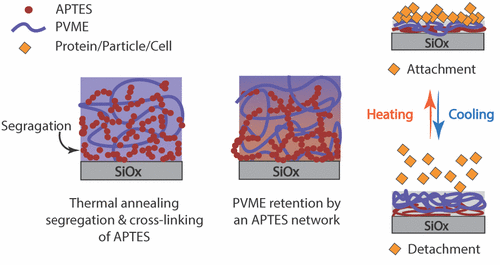当前位置:
X-MOL 学术
›
ACS Biomater. Sci. Eng.
›
论文详情
Our official English website, www.x-mol.net, welcomes your feedback! (Note: you will need to create a separate account there.)
Thermoresponsive Poly(vinyl methyl ether) (PVME) Retained by 3-Aminopropyltriethoxysilane (APTES) Network
ACS Biomaterials Science & Engineering ( IF 5.8 ) Pub Date : 2020-11-10 , DOI: 10.1021/acsbiomaterials.0c01376 Elham Malekzadeh 1 , Bi-min Zhang Newby 1
ACS Biomaterials Science & Engineering ( IF 5.8 ) Pub Date : 2020-11-10 , DOI: 10.1021/acsbiomaterials.0c01376 Elham Malekzadeh 1 , Bi-min Zhang Newby 1
Affiliation

|
Thermoresponsive polymers (TRP)s have been widely used for various applications from controlling membrane fouling in separation to cell/cell sheet harvesting in regenerative medicine. While poly(N-isopropylacrylamide) (pNIPAAm) is the most commonly used TRP, less expensive and easily processed poly(vinyl methyl ether) (PVME) also shows a hydrophilic to hydrophobic transition at 32–35 °C, near physiological conditions. In this study, we investigated the processing conditions for retaining a stable layer of PVME thin film on silica surfaces via entrapment in a 3-aminopropyltriethoxysilane (APTES) network. In addition, the thermoresponsive behaviors (TRB) of the retained PVME films were evaluated. Blend thin films of PVME/APTES with 90:10 and 50:50 mass ratios were spin-coated from their solutions in ethanol under ambient conditions and then annealed in a vacuum oven at 40, 60, 80, or 120 °C for 1, 2, or 3 days. The annealed films were then thoroughly rinsed with room temperature water and then soaked in water for 3 days. Our results showed that annealing at a temperature of ≥40 °C was necessary for retaining a PVME film on the surface. The higher annealing temperature led to greater film retention, probably due to the formation of a tighter APTES network. Regardless of processing conditions, all retained PVME films showed TRB, determined by water contact angles below and above the transition temperature of PVME. Additionally, particle attachment and protein adsorption on retained PVME films showed lower attachment or adsorption at room temperature as compared to that at 37 °C, and a greater difference was observed for the 90:10 blend where more PVME was consisted. Furthermore, human mesenchymal stem cells attached and proliferated on the retained PVME surfaces at 37 °C and rapidly detached at room temperature. These results illustrated the potential applications of PVME surfaces as thermoresponsive supports for low-fouling applications and noninvasive cell harvesting.
中文翻译:

3-氨基丙基三乙氧基硅烷(APTES)网络保留的热敏性聚(乙烯基甲基醚)(PVME)
热敏性聚合物(TRP)已广泛用于各种应用,从控制分离中的膜污染到再生医学中细胞/细胞片的收获。而poly(N-异丙基丙烯酰胺(pNIPAAm)是最常用的TRP,价格便宜且易于加工的聚(乙烯基甲基醚)(PVME)在生理条件下,在32-35°C下也显示出从亲水到疏水的转变。在这项研究中,我们调查了通过在3-氨丙基三乙氧基硅烷(APTES)网络中截留而在二氧化硅表面上保持稳定的PVME薄膜层的工艺条件。此外,评估了保留的PVME膜的热响应行为(TRB)。在环境条件下,从其在乙醇中的溶液中旋涂质量比为90:10和50:50的PVME / APTES混合薄膜,然后在真空烘箱中于40、60、80或120°C退火1, 2或3天。然后将退火过的薄膜用室温水彻底漂洗,然后在水中浸泡3天。我们的结果表明,在≥40°C的温度下进行退火对于将PVME膜保留在表面上是必要的。较高的退火温度可能导致更大的薄膜保留,这可能是由于形成了更紧密的APTES网络所致。不论处理条件如何,所有保留的PVME膜均显示出TRB,这取决于PVME转变温度以下和以上的水接触角。此外,与37°C相比,在室温下保留的PVME膜上的颗粒附着和蛋白质吸附表现出更低的附着或吸附,对于90:10的共混物(其中包含更多的PVME),观察到更大的差异。此外,人类间充质干细胞在37°C附着并在保留的PVME表面上增殖,并在室温下迅速脱离。
更新日期:2020-12-14
中文翻译:

3-氨基丙基三乙氧基硅烷(APTES)网络保留的热敏性聚(乙烯基甲基醚)(PVME)
热敏性聚合物(TRP)已广泛用于各种应用,从控制分离中的膜污染到再生医学中细胞/细胞片的收获。而poly(N-异丙基丙烯酰胺(pNIPAAm)是最常用的TRP,价格便宜且易于加工的聚(乙烯基甲基醚)(PVME)在生理条件下,在32-35°C下也显示出从亲水到疏水的转变。在这项研究中,我们调查了通过在3-氨丙基三乙氧基硅烷(APTES)网络中截留而在二氧化硅表面上保持稳定的PVME薄膜层的工艺条件。此外,评估了保留的PVME膜的热响应行为(TRB)。在环境条件下,从其在乙醇中的溶液中旋涂质量比为90:10和50:50的PVME / APTES混合薄膜,然后在真空烘箱中于40、60、80或120°C退火1, 2或3天。然后将退火过的薄膜用室温水彻底漂洗,然后在水中浸泡3天。我们的结果表明,在≥40°C的温度下进行退火对于将PVME膜保留在表面上是必要的。较高的退火温度可能导致更大的薄膜保留,这可能是由于形成了更紧密的APTES网络所致。不论处理条件如何,所有保留的PVME膜均显示出TRB,这取决于PVME转变温度以下和以上的水接触角。此外,与37°C相比,在室温下保留的PVME膜上的颗粒附着和蛋白质吸附表现出更低的附着或吸附,对于90:10的共混物(其中包含更多的PVME),观察到更大的差异。此外,人类间充质干细胞在37°C附着并在保留的PVME表面上增殖,并在室温下迅速脱离。


























 京公网安备 11010802027423号
京公网安备 11010802027423号